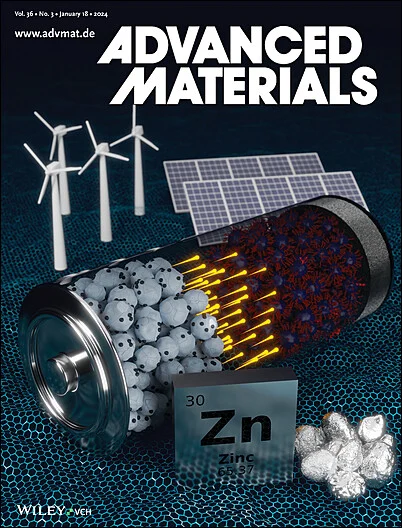基于分子工程共轭聚咔唑框架的可扩展太阳能驱动过氧化氢生产的无偏压光电化学系统。
IF 26.8
1区 材料科学
Q1 CHEMISTRY, MULTIDISCIPLINARY
引用次数: 0
摘要
太阳能驱动的光电化学(PEC)合成成为生产过氧化氢(H2O2)的一种有前途的途径,重新构想了能源密集型的蒽醌方法。然而,将PEC系统从实验室规模的原型扩展到实际的大面积安装仍然是一个重大的科学和工程挑战,主要原因是光电极表面的催化选择性有限,并且在升级过程中性能迅速下降。该研究提出了一种模块化、无偏置的PEC系统,设计用于可扩展的太阳能驱动H2O2生产。含有合理设计的二乙炔和蒽醌基团的共轭聚咔唑框架(CPFs)作为分子精确的催化层,在光阳极和光电阴极同时实现双电子通路。由此产生的光阳极和光电阴极产生H2O2的法拉第效率分别为94.08%和95.50%。将这些光电极集成到1平方厘米的无偏串联PEC装置中,实现了2.11%的太阳能-化学转换(SCC)效率。更重要的是,通过模块化组装策略,将这些设备扩展到1平方米的无膜PEC面板反应器,在自然阳光下的平均SCC效率为1.10%,这是迄今为止报道的最大的太阳能驱动的H2O2生产PEC系统。该研究弥合了实验室规模实验与实际应用之间的差距,为分散式太阳能驱动的H2O2生产提供了可扩展的框架。本文章由计算机程序翻译,如有差异,请以英文原文为准。
Bias-Free Photoelectrochemical System for Scalable Solar-Driven Hydrogen Peroxide Production via Molecularly Engineered Conjugated Polycarbazole Frameworks.
Solar-driven photoelectrochemical (PEC) synthesis emerges as a promising pathway to produce hydrogen peroxide (H2O2), reimagining the energy-intensive anthraquinone method. However, scaling PEC systems from laboratory-scale prototypes to practical large-area installations remains a significant scientific and engineering challenge, primarily due to limited catalytic selectivity at photoelectrode surfaces and rapid performance degradation during upscaling. This study presents a modular, bias-free PEC system designed for scalable solar-driven H2O2 production. Conjugated polycarbazole frameworks (CPFs) containing rationally designed diacetylene and anthraquinone moieties functions as molecularly precise catalytic layers, enabling concurrent two-electron pathways at both the photoanode and photocathode. The resulting photoanode and photocathode deliver faradaic efficiencies of 94.08% and 95.50%, respectively, for H2O2 production. Integrating these photoelectrodes into a 1 cm2 unbiased tandem PEC device achieves a solar-to-chemical conversion (SCC) efficiency of 2.11%. More importantly, scaling these devices to a 1 m2 membrane-free PEC panel reactor via a modular assembly strategy yields an average SCC efficiency of 1.10% under natural sunlight, representing the largest reported solar-driven PEC system for H2O2 production to date. This study bridges the gap between laboratory-scale experimentation and real-world applications, providing a scalable framework for decentralized, solar-driven H2O2 production.
求助全文
通过发布文献求助,成功后即可免费获取论文全文。
去求助
来源期刊

Advanced Materials
工程技术-材料科学:综合
CiteScore
43.00
自引率
4.10%
发文量
2182
审稿时长
2 months
期刊介绍:
Advanced Materials, one of the world's most prestigious journals and the foundation of the Advanced portfolio, is the home of choice for best-in-class materials science for more than 30 years. Following this fast-growing and interdisciplinary field, we are considering and publishing the most important discoveries on any and all materials from materials scientists, chemists, physicists, engineers as well as health and life scientists and bringing you the latest results and trends in modern materials-related research every week.
 求助内容:
求助内容: 应助结果提醒方式:
应助结果提醒方式:


